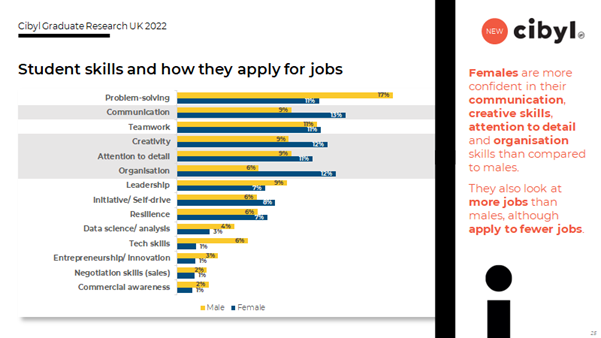It’s becoming increasingly challenging to find graduates and school leavers with strong communications skills. Simon Martin, CEO at GTI explains and offers advice.
The tech skills shortage is much discussed but employers are increasingly telling us that finding graduates and school leavers with strong communication skills is a bigger challenge than ever.
I said a few opening words at the ISE Student Recruitment Conference in Brighton this year and mentioned this, along with the student mental health crisis. I suggested that all of us at the conference, back face-to-face, should set a communication example…try to meet new people, ask what they do and show genuine interest.
It’s probably no surprise that nearly all graduate skills, attributes and career readiness frameworks developed by educators and employers start with communication. Which makes me, a dad of two Gen Z and one Gen Alpha, worry even more that I’m not setting a good example – distracted by notifications and communicating on the family WhatsApp, even when everyone is at home!
Mismatch between employer and student views
Employers feel communication skills are lacking but students feel it is a top strength.
The ISE Student Development 2022 report cited business communication as the skill that school and college leavers most need to develop at the point of hire.
But from students’ perspective there’s an interesting and potentially really important mismatch.
GTI’s Cibyl surveys 100,000 students and school leavers each year to help employers, universities and schools support and engage with them. Students applying for jobs cite communication as one of their top two strengths, second only to problem-solving. Perhaps unsurprisingly, females are even more confident than males in this.

Why might the mismatch be happening?
The definition of ‘communication’ could be part of it. There’s unanimous agreement on the importance of communication but equal disparity between what good communication looks like.
We know that real-world collaborations and interactions are ambiguous and fluid. Sometimes the opportunity or problem being discussed isn’t even clear, let alone the constraints or peoples’ ideas for a solution.
Plans tend to unfold and need a mix of skills and attributes to progress – not just communication and problem solving but things like enthusiasm, flexibility, self-awareness, data literacy and resilience.
Students generally leave education with strong short-form communication (social platform style) and formal essay and presentation style skills. So they understandably score themselves well on communication. But the skills developed so far may be less multi-dimensional – lacking experience of radical ambiguity or drawing together multiple complex ideas to present in a simple way, and not enough practice in using the strange mix of attributes needed to ‘communicate’ in organisations.
Thinking about the attraction and selection experience, two-way communication involves feedback from the receiver to the sender. One of the challenges in early careers maybe a lack of genuine meeting of minds and understanding through the process. Leaving candidates and recruiters frustrated with misunderstanding and misinterpretation. Cibyl data consistently shows candidates would like more helpful, clearer and timely communication.
Helping to close the gap
Communication is, of course, a huge topic and challenge in humanity. But in the spirit of a sector which doesn’t just point out challenges but generally does something about it, here are a few thought:
Developing skills
Employers being as explicit as possible in describing the desired communication and collaboration will help educators and careers services further develop student skills.
Employers generally want people who communicate well with others as part of their teams, who listen to others, seek ideas, respond to feedback, offer contributions and challenges that allow those around them to achieve collective goals and outcomes. Working in a hybrid world also means effective collaboration has taken on new dimension.
Careers teams often signpost practical quick-to-digest resources. Googling ‘graduate communication skills’, a targetjobs article is a top result that shares simple tips. Job simulations are a scalable way to help provide role insight and skills. But experience of ambiguity normally comes best from real-world work experience; work projects embedded in the curriculum or extra-curricular, internships and work placements.
Providing tools for students to practice and develop their skills and go through assessment examples before they apply is an increasing focus of not just universities but also employers focused on diversifying their intake. And, of course, providing diverse experiences, training and quick feedback when in role.
Looking creatively for strong communicators
There are groups of students with outstanding communication and people skills who may not be obvious to employers. For example, students working part time in careers teams, proactively understanding and supporting other students. Or students who are part of comedy or drama societies when they may be studying STEM and so have developed a mix of attributes.
Reflecting good communication in the hiring process
For candidate experience, difficult as it can be to resource, speed of communication response is key. One of the main reasons candidates reneged on offers in 2021/22 was the process was either too long or recruiters didn’t respond in the time that they said they would. Leaving often the most sought-after candidates to go to employers who responded faster. GTI’s Recruiting Solutions and other RPO providers can help add resource to do this.
New rules of communication
Do we need to write new rules for candidate and employer communication during recruitment and when in role? Taking account of generational differences, hybrid working and a transforming, ever more ambiguous business world. It’s hard to find people who ‘get’ the audience as well as employer needs. And harder still to find people who can also create content, imagery and skills initiatives that really work. But surely worth the effort and investment in trial and error?
In conclusion
Students and school leavers have stronger taught communication skills than any previous generation. But the challenge is that real world situations are multi-layered, often with huge ambiguity.
We should be asking ourselves whether we role model excellent business communication skills in all that we do? Can we articulate the skills that we’re expecting and are we finding enough high impact ways to develop emerging talent in a hybrid world? Our own communication may play the biggest role in closing the gap.
Read more insight and advice on skills


0 Comments